There are many forms of Night Vision Imaging Systems (NVIS) that help our nation’s warfighters, pilots, and other professionals. Known as Night Vision Goggles (NVG), these devices are highly specialized and amplify various wavelengths of light allowing the user to “see” in darkness.
While military and aerospace use are widespread, the same technology is available commercially to the public with products such as smart day/night binoculars, hunting scopes, and maritime navigation goggles. NVIS and NVG systems use highly specialized and use costly materials such as films, lenses, and advanced optics to achieve this performance.
There are numerous advantages to using the NVG systems while in theatre. NVG systems help operational safety and situational awareness. Additionally, NVG and NVIS systems increase the wearer’s ability to see and avoid obstructions in darkness or at night. Wearers must be trained properly and given ample time for their eyes to adjust to the darkness for the goggles to be effective. While goggles and helmets can increase fatigue due to their weight and the potential for eyestrain, they serve an important role in countless operations and missions.
These products work by detecting small amounts of light and amplifying it, offering the wearer an augmented view of their otherwise dark surroundings. Goggle technologies can detect specific wavelengths of light, boosting it to create visible images from darkness. Powered by lithium batteries, devices are helmet-mounted or handheld, allowing the user’s complete mobility. These systems can be especially expensive with commercial-grade equipment costing several hundred dollars and high-performance goggles costing thousands of dollars or more.
Since night vision products take existing light and increase it, one of their inherent flaws is that they are susceptible to blooming or flaring when bright light is shone in their view. As the goggles work to detect and augment low visible levels of light, a source such as instrument LEDs or a flashlight can significantly disrupt the image. And depending on the situation, the image disruption can be near blinding to the wearer.
This creates a challenge for pilots, drivers, and captains who must scan the horizon using night vision imaging to operate their vehicle. If the dashboard or cockpit of their vehicle is not properly backlit, the operator can be blinded by glancing down at their controls. To combat this, there are Federal regulations and industry specifications that define the appropriate intensities and wavelengths of light in the electromagnetic spectrum that are NVIS compliant.
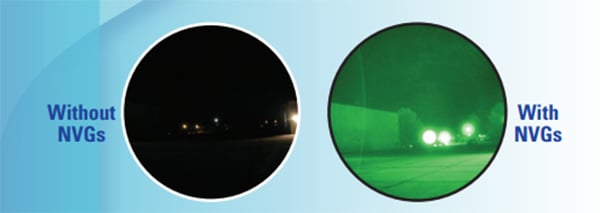
Example of view without and with NVGs.
Source: FAA Safety.gov
Mil-STD-3009: Why NVIS Compliance is Necessary
According to FAA regulations, the aircraft lighting system must not cause any loss of sight or visual acuity from the baseline visual standard. The baseline visual standard for each aircraft, vessel, or vehicle will vary based on several circumstances. This can include a pilot/co-pilot cockpit arrangement, and single or open cockpit configurations as well. To be compliant, the onboard lighting system cannot impact the operator’s ability to safely navigate. These instruments and lighting systems include the master warning/caution lights, fire lights, and caution warning panel elements that are integral for operator’s safety. The use of NVG goggles cannot impact the observation of these systems especially when looking cross-cockpit. Federal regulations also cover aftermarket modifications to the instrument panel, annunciators, lower console, and overhead panels. These regulations also consider external lighting sources such as position lights, strobe lights, search lights, etc., since they can be within the operator’s field of view.
Mil-STD-3009 is a widely known military specification that details the requirements for aircraft cockpit indicators and lighting systems. This specification provides chromaticity guidance for the industry by standardizing the limits of specific light schemes. Chromaticity, which is the measurement of lights wavelength composition, characterizes the color limits of a light source regardless of its intensity. What this means is chromaticity defines the specific light composition, and not actually how bright the light is. Instead, chromaticity helps quantify the intensity of each component of light. This is important because the NVG and NVIS systems function by targeting and amplifying specific wavelengths of light.
The standard light schemes for Mil-STD-3009 are defined as Green A & B, Yellow, Red, and White. Each has a specific value for the 3 components of its color, which are represented as the x, y, and z chromaticity coordinates known as u’, v’, and r. By using these limits, specific light sources can be measured with instruments and compared to tabulated limits within Mil-STD-3009.
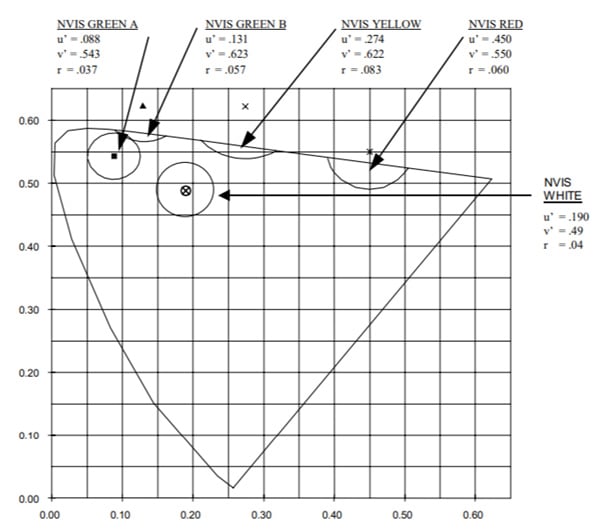
NVIS lighting color limits.
Source: MIL-STD-30092 (February 2001)
Material Selection and Testing
Most cockpit instruments can be backlit using discrete lighting of some sort. Bulbs, diodes, and specialty filters are commonly used to achieve compliance with the various industry requirements. Incandescent bulbs may be an appropriate backlighting solution, but they can generate heat and require sufficient current draw to operate. LEDs are another option to backlight instrument panels because of their low power consumption and the fact that they are offered in a wide range of package sizes. Depending on the light source chosen, the final arrangement may require testing to measure the chromaticity of the emitted light. This can be accomplished using special test equipment including a Spectroradiometer.
These measurements would be compared to the limits of Mil-STD-3009. This specification defines the colors as Green A, Green B, Yellow, Red, and White. This specific chromaticity requirement can be satisfied by using specialty light sources, lens, or films that can screen out all unwanted wavelengths of light that would be harmful to someone wearing a NVIS/NVG headset.
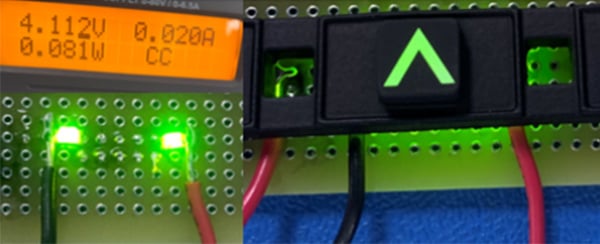
150 mcd luminance SMT LED.
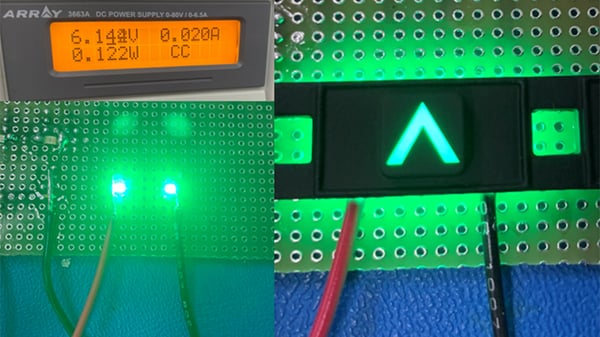
250 mcd luminance SMT LED.
Off-the-shelf LEDs can be used to backlight the panel as they represent a low-cost lighting solution. However, these LEDs can require a specialty lens or film to be used in conjunction to satisfy the mil standard chromaticity requirements. To operate, the light source (in this case an SMT LED) is firmly secured to a circuit board and properly wired or soldered. Once energized the LED will shine at its designed luminance, direction, and color. While the LED is on, light will pass through the filter then on to the NVIS/NVG user and will be perceived as NVIS/NVG friendly light. These lenses or films must be cleverly incorporated into the instruments and any buttons or switch bezels such that they do not interfere with the desired keypad operation or create a distraction to the pilot.
The lenses and films function quite similar to the way a theatre production spotlight operates and changes color; at least this is the way the older technologies worked. A lens is placed in front of a light source, and the light shines through the material. But in this case, the lenses sole purpose is to eliminate undesired wavelengths of light. Both the light source color and lense color can vary, but it’s recommended to pair the source and film together.
The options available from NVIS/NVG filter suppliers are typically NVIS Green A, Green B, Yellow, Red, and White. For example, if NVIS Green B is a requirement for your project, a white or green light source can be chosen and paired with NVIS Green B compliant filtering material.
To achieve this level of performance, filter materials are manufactured using highly specialized processes that can involve vapor deposition steps and exotic materials. Because of this, their manufacturing timeline is lengthy and usually custom ordered. It’s not uncommon for minimum order quantities to be 500 pieces and 16 weeks for NVIS/NVG compliant material. This fact makes development and initial production runs challenging since the NVIS/NVG material is required to perform chromaticity measurements. Epec maintains stock of several key NVIS/NVG materials to support rapid product development and qualification efforts for various low voltage applications. Don’t be fooled by misleading online suppliers of Mil-STD-3009 materials (especially those with eccentric websites). This material may not meet its quoted performance or delivery commitments, or even show up at all.
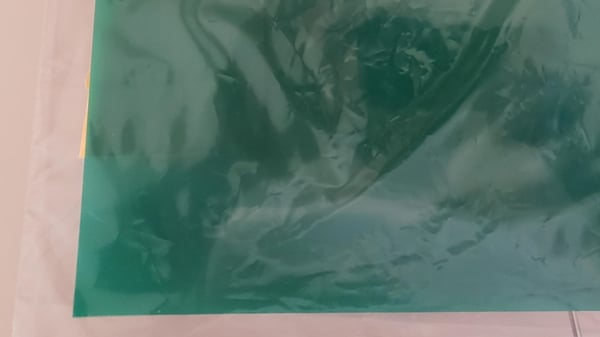
Example of NVIS film.
Getting Started
One of the first steps in developing any NVIS or NVG compliant backlighting system is to confirm the specific section of Mil-STD-3009 that applies. The options include NVIS Green A, NVIS Green B, NVIS Yellow, NVIS Red, and NVIS White, with the most frequent being NVIS Green A and Green B. Next, it is important to define the overall system architecture; do this early and complete this by use of a block diagram. Once this block diagram is created, the system elements that require backlighting and switch operation can be more clearly defined and expanded upon.
Many critical design requirements hinge on the backlighting scheme, the type of buttons required, and whether the buttons themselves need to be backlit. Other considerations include if the backlighting should be dimmable, how the dimming function is controlled, and what buttons enable the dimming function. There are many details that need to be finalized well before the first PCB is laid out. Because of this a full-service manufacturing partner like Epec can help offer design and manufacturing services for both the initial concept development as well as full-rate production.
Key Takeaways
- HASL Is No Longer Ideal for Modern Flex Designs: The uneven surface finish and lack of flatness in HASL make it incompatible with fine-pitch SMT components, BGA packages, and ZIF contacts, all of which require high coplanarity and flat pads.
- Thermal Shock Can Damage Flex Circuits: The HASL process requires flex circuits to be submerged in molten solder. If not properly baked beforehand to remove moisture, this can cause delamination or structural damage due to steam expansion inside the layers.
- Material Compatibility Is a Major Concern: The adhesives used in flex circuits (acrylic or epoxy-based) have lower heat tolerance than polyimide, increasing the risk of damage during the high-temperature HASL process, especially for RoHS-compliant (lead-free) versions that run hotter.
- Handling Challenges During Processing: Because flex circuits lack the rigidity of traditional boards, they are more difficult to run through HASL machinery. Even with support frames, movement during air knife passes can cause inconsistent solder thickness or physical damage.
- ENIG Is the Preferred Surface Finish for Flex: Electroless nickel immersion gold (ENIG) has largely replaced HASL in flex circuit manufacturing due to its superior flatness, reliability, and compatibility with the thermal and mechanical properties of flexible materials.
















